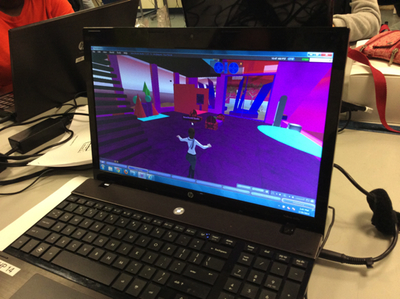Grade Level
11+
minutes
Multi-day
subject
Engineering and Tech
Activity Type:
experimental design, technology
In late February, 20 teenage girls arrived at the New York Hall of Science in Queens, New York to improve their digital design skills as part of a “Girls First Digital Studio” weeklong workshop. The kids, ages 12-18, had heard about the workshop through the Mozilla Labs’ Hive Learning Nework NYC, a collective of programs and organizations that create learning experiences that connect youth with technology. Rather than spend their winter break from school watching television, the girls chose to be on the lower level of the museum in a digital lab, flying through landscapes and architecture that they designed using an open-source software tool called New World Studio.
The software enables users to furnish a virtual world by designing complex three-dimensional objects from simple shapes that they stretch, color, and link in infinite combinations. Because of its versatility, New World Studio can be much more challenging to use than software that provides pre-designed building elements like walls or cubes that snap together.

Over the course of the week, the girls worked in small groups to design three virtual spaces: one that represented the school or organization they came from, one of a dream or a nightmare, and a final project of their own choosing. They spent the first day sketching their designs on paper, assigning tasks to group members, and deciding on the textures, characters, and colors that they would use in their completed designs. After that, they got right to work digitizing their inventions. Meanwhile, volunteers and program staff stood by to ease the transition from paper to virtual design by offering advice and software cheat sheets.

Work time was loud but generally focused, and only occasionally interrupted by short technique tutorials or by Skype sessions led by women design and computing professionals. The organizers of the workshop found that girls naturally formed groups of different age, skill level, and English proficiency over the course of the week. Some students acted as language translators, some as digital design tutors, and others as mentors for younger students.
When I visited during the fourth day of the workshop, the girls were still deeply immersed in troubleshooting and perfecting their designs. Joyce (12) and Grace (12), both veterans of the video game Minecraft, agreed that working with flexible shapes is much more difficult than working with the rigid blocks in Minecraft. “You can think everything is all lined up, and then you’ll find a big gap. It takes a long time” Grace said. For others, the challenge was working together to create a single vision, like deciding where to put doors, or how large to make the trees in the front yard of a building.
The completed projects were dazzling and included multi-story apartments, a pagoda-style greenhouse, elaborate gardens, and a musical auditorium complete with a singing choir. One pair of designers, both in middle school, created a celestial playground with a starry sky, solar system backdrop, and a grassy hill with telescopes for guests to use. The result was an immersive and welcome escape from the cold cloudy day outside.

Related Links
Meet the Writer
About Ariel Zych
@arieloquentAriel Zych is Science Friday’s director of audience. She is a former teacher and scientist who spends her free time making food, watching arthropods, and being outside.
